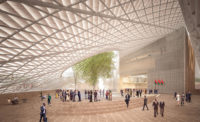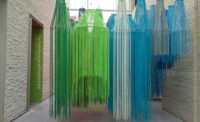Sinking Real-Estate Market Forces Architects to Reconsider their Prospects
In recent years, architects descended upon Dubai, eager to capitalize on its feverish building boom. But while the Persian Gulf city’s sprawling skyline is still dotted with cranes, the market here has fizzled.
As of early February, more than half of Dubai’s real estate projects were on hold or canceled, from the 3,281-foot-tall Nakheel Tower designed by Woods Bagot to the Hydropolis, a 220-suite underwater hotel envisioned by designer Joachim Hauser. Analysts predict that Dubai property values, in total, will decline up to 60 percent in 2009 after years of record growth. Given this drastic turn of events, architects are being forced to reconsider their prospects in the region.

“Everyone is taking a real wait-and-see approach,” says Wayde Tardif, an American designer who in 2007 co-founded POSIT Studio in Dubai. Tardif remains optimistic, noting that the slowdown will normalize the market and allow architects to catch their breath. He predicts a rebound in 16 to 18 months; he doesn’t foresee a forgotten city full of empty towers. “Dubai has too much pride for that,” he says.
In the past decade, Dubai, located in the United Arab Emirates (UAE), has embarked on ever-grander projects at breakneck speed in hopes of becoming a major world metropolis. Today, its economy relies on tourism, real estate, and financial services; oil revenues contribute less than 10 percent to its GDP.
Initially some thought the desert boomtown could skirt the global financial crisis. By October, however, foreign investors were vanishing, local lenders were retrenching, and oil prices were taking a dive. In recent months, The National, a UAE newspaper for expatriates, has been peppered with reports of mass layoffs. “There are many instances of consultant firms reducing staff by more than 50 percent, or closing their Dubai office altogether,” says Scott Hyndman, a development manager at a Dubai-based property company. Some stories claim that hundreds, if not thousands, of cars sit abandoned at the Dubai airport, presumably left there by foreigners fleeing the country.
While holding faith in Dubai, many architecture firms are shifting their focus 70 miles to the southwest, to oil-rich Abu Dhabi. The capital of the UAE, Abu Dhabi has evolved gradually over the decades and often is regarded as a more livable—and more stable— urban center. “Where Dubai has been a speculative market, I think Abu Dhabi is a much more serious, play-by-the-rules market,” notes says Steven Miller, FAIA, managing director of FXFOWLE’s Dubai office. His firm is actively pursuing work in Abu Dhabi, where major developments such as Saadiyat Island—a $27 billion multi-use project with buildings by Jean Nouvel, Zaha Hadid, and Frank Gehry—are reportedly still on schedule.
Guy Source, a UAE-based employment recruiter for the architecture industry, agrees that Abu Dhabi seems less affected by the financial crisis than Dubai. He adds that other Middle Eastern markets hold promise as well, noting that there are jobs waiting to be filled in Qatar, Kuwait, and Saudia Arabia.
FXFOWLE’s Miller is no stranger to Saudia Arabia; he first worked there during the recession of the mid-1970s. Now, as he hunts for work beyond once-fertile Dubai, he is returning to familiar territory. “Saudia Arabia is off the charts right now,” Miller says. “We’re very busy there.”


Post a comment to this article
Report Abusive Comment